Thermopile temperature sensors offer the advantage of non-contact temperature measurement, which has made them more popular than traditional contact-type temperature sensors. These sensors use infrared (IR) radiation for heat transfer, and are commonly used in portable devices such as infrared thermometers. Another attractive application for thermopile sensors is temperature monitoring of moving objects, where contact-based temperature sensors have serious drawbacks. Here is an overview of thermopile infrared temperature sensors to help you take full advantage of this technology.
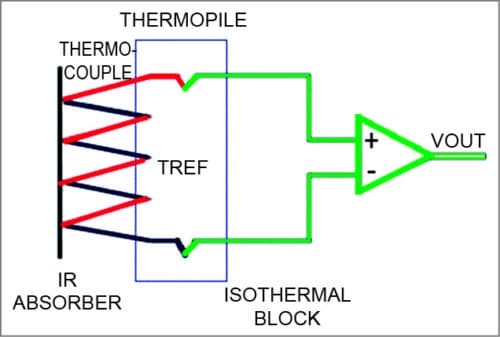 Fig. 1: Structure of a thermopile
Fig. 1: Structure of a thermopile
Sensor insight
A thermopile infrared sensor has a number of thermocouples connected in series that have their ‘hot’ junctions attached to a thin infrared absorber, usually on a micro-machined membrane on a silicon chip. The exchange of infrared radiation between the absorber and the object in front of it makes the temperature of the absorber rise or fall, depending on the temperature difference between it and the object.
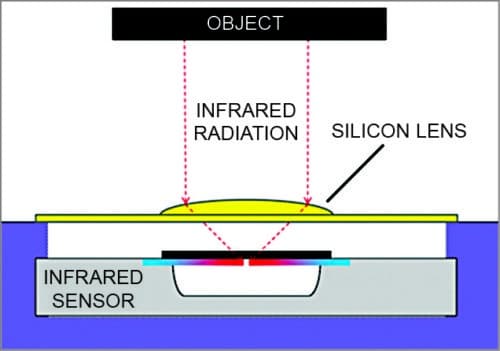
Fig. 2: Silicon lens/filter execution
To properly measure the object’s temperature, the object must completely fill the sensor’s field of view (FOV). This ensures that the infrared radiation affecting the thermopile is coming only from the object of interest and not its background. Besides, use of a filter and lens greatly enhances the performance of infrared sensors.
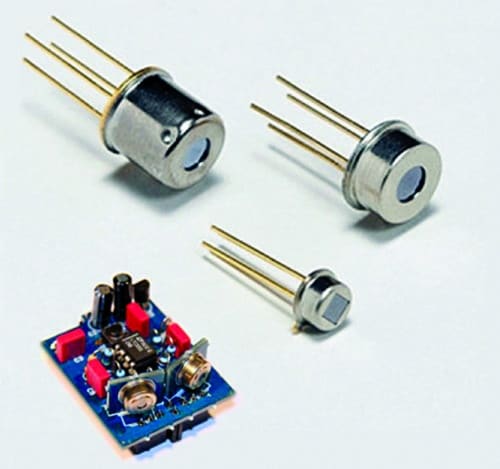
Fig. 3: Thermopile sensors/modules
Plain silicon is completely opaque to visible light, but transparent to wavelengths longer than 2µm where most spectral emission occurs for temperatures below 500K (200°C or 450°F). Therefore silicon material can be used for filtering the visible and ultraviolet (UV) spectrum from affecting the sensor. In order to increase the sensor’s sensitivity (or the distance from which the sensor can measure a fixed-size object), micro-machined silicon lens is widely used to concentrate more infrared radiation onto the sensor or limit its field of vision.
Sensor playground
Nowadays, thermopile infrared (IR) temperature sensors are available with various lenses/filters, allowing use in real-world applications ranging from industrial pyrometers to lifecare devices. Depending on the sensor, the output signal can be the standard resistance output or analogue/digital signal output.
Various sensor packages (useful for hobbyists and makers alike), including hermetically sealed housings, stainless-steel packaged housings and pre-wired modules, are now available at affordable prices. All of these thermopiles are designed to measure temperature from a distance by detecting the object’s infrared energy. The thermopile sensing element, composed of small thermocouples on a silicon chip, absorbs the energy and produces an output signal. A reference sensor is also included in the package as a reference for compensation.
TPS334 thermopile detector. TPS334 thermopile detector, from Excelitas, is a standard sensor that employs a chip of 0.7×0.7mm2 absorber size, and a 30-kilo-ohm thermistor as the temperature reference component. Its round window opening is outfitted with a 5.5µm long-pass infrared filter. TPS334 is available in TO-5 type package.
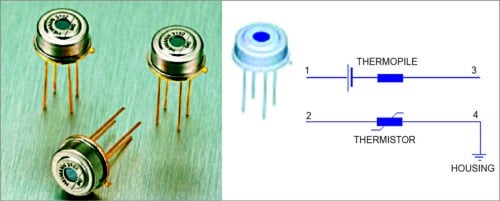
Fig. 4: (L) TPS334 package and (R) its pin drawing
A2TPMI thermopile. A2TPMI, another thermopile from Excelitas, is a versatile infrared thermopile sensor with an integrated configurable ASIC for signal processing and ambient temperature compensation. This integrated infrared module senses the thermal radiation emitted by objects and converts it into an analogue voltage. Because of the internal digital signal processing and 8-bit resolution of the internal control registers, A2TPMI has improved accuracy for adjustment and improved performance. Its E2PROM technology allows unlimited change in the configuration. Due to integration of sensor and electronics in a compact TO-39 (6-pin) housing, A2TPMI is a good solution for hobbyists too. Functional diagram of A2TPMI is shown in Fig. 5.
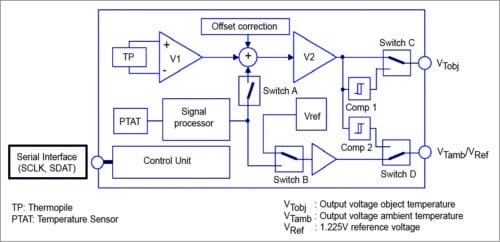
Fig. 5: Functional diagram of A2TPMI
MLX90614. MLX90614 from Melexis is a very popular infrared thermometer for non-contact temperature measurements. It is a perfect blend of an infrared sensitive thermopile detector chip and the signal conditioning ASSP integrated in the same TO-39 (4-pin) housing. The thermometer comes with a low-noise amplifier, 17-bit analogue-to-digital converter and powerful digital signal processor unit. It is factory calibrated with a digital pulse-width modulation (PWM) and system management bus (SMBus) output.
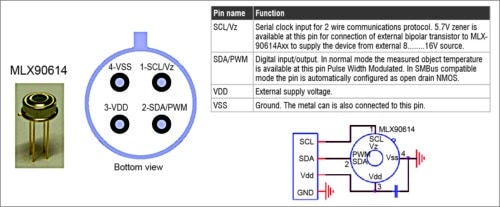
Fig. 6: Pin configuration of MLX90614
Design guide
It is not very difficult to connect thermopiles with a serial interface like A2TPMI to microcontrollers. However, for sensors without built-in processor (for example, TPS334), it might become necessary to add an external signal processing circuitry based on a high-quality, low-noise type operational amplifier like LTC1050/1051. For DIYers, Texas Instruments’ TMP006 infrared thermopile sensor based module is another low-cost but good option. Original schematic diagram of the module is shown in Fig. 7.
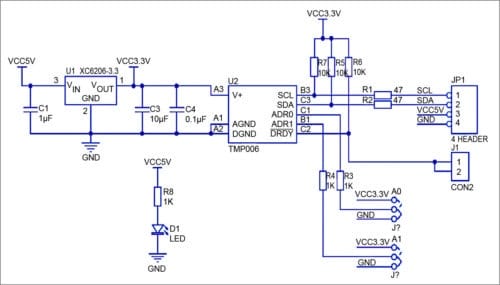
Fig. 7: TMP006 schematic
Maintenance and handling
Since thermopile sensors are static-sensitive, unused sensors must be stored in a conductive material for protection against static discharges and static fields. Stresses above those listed under absolute maximum ratings and reversed polarity of power supply damage the sensor. Also, thermopile sensors should not be exposed to direct sunlight or moisture. Be careful when you handle these sensors, and avoid touching their window. Oil from your fingers and dust or dirt may adversely affect the performance of the sensor. In such cases, the optical window (filter and lens) can be cleaned with alcohol and a cotton swab.
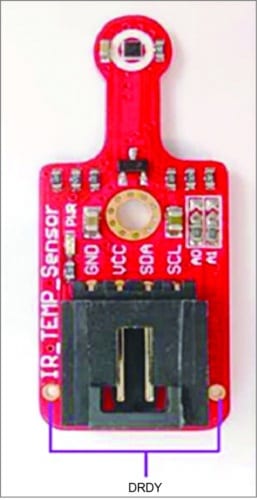
Fig. 8: TMP006 board image
In summary, being able to read the temperature of an object without even touching it is simply awesome. Thermopile sensors can do just that. No doubt, thermopile infrared temperature sensors provide the best combination of small size, low power and low cost for non-contact temperature measurements. Fortunately, these are not as trivial to implement as traditional contact based temperature sensors!








The article covers in depth working of Thermopile sensors, with great learning tips. As an instrumentation engineer this article helps me understand more on these type of sensors as applied in industrial measurements.